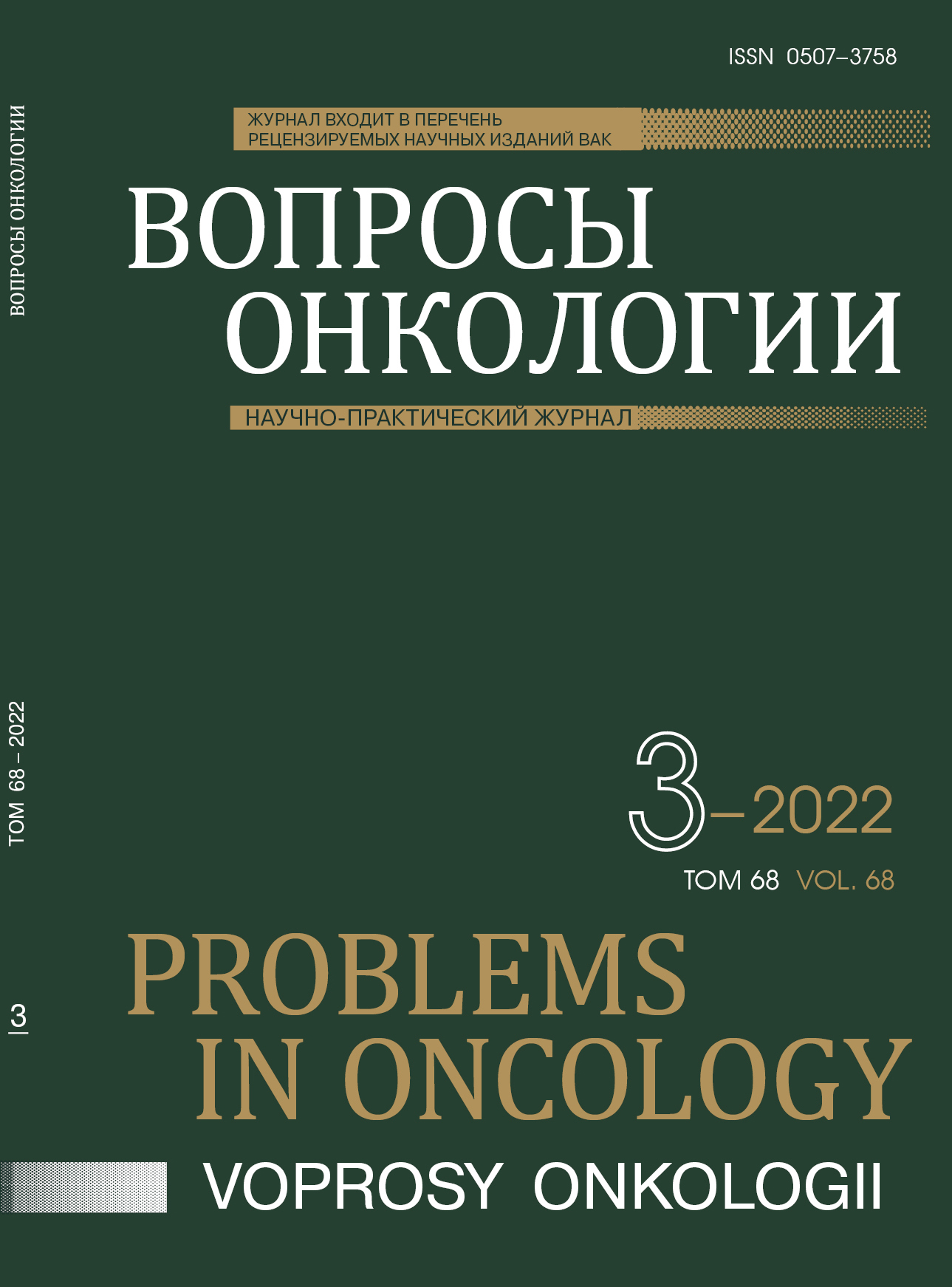Abstract
The incidence of multifocal/multicentric (MF/MC) breast cancer ranges from 6% to 60% [1, 2, 3]. According to the study, in 170 patients with this disease, the prognostic value of determining the T-staging of MF/MC breast cancer using Tsum, which is the sum of the longest tumor diameters, was proven.
Background. The aim of this study is to assess the predictive value of T-staging according to total lesion volume versus the size of the largest tumor in the breast in patients with MF/MC breast cancer.
Materials and methods. 383 outpatient cards and case histories of patients with MF/MC breast cancer aged 28 to 84 years (55.0±11.3 years) were analyzed for the period from 2001 to 2016. T-stage multifocal and multicentric tumors was defined according to the size of the largest lesion (Tmax) and the sum of the longest diameters of the remaining breast lesions (Tsum).
Results. MF and MC tumors were found in 170 of 383 patients (44.4%) diagnosed with breast cancer. Based on the information in the literature available to us on the prognostic role of tumor process indicators Tsum and Tmax, specific for breast cancer MF and MC, we analyzed the relationship of these indicators with time to outcome in a cohort of patients who experienced distant metastasis or death. When determining the stage of the disease according to Tsum, in 41 (24%) patients the stage increased from I to II, in 21 (15%) — from II to III and in 4 (2.35%) — from I to III stages.
Conclusions. When determining the stage of the disease according to Tsum in 41 patients (24%), the stage increased from I to II and in 21 patients (15%) from II to III, in 4 patients from I to III (2.35%). Using several statistical methods to assess discriminative ability, we did not find a significant superiority of Tsum over Tmax in terms of overall survival.
References
Egan RL. Multicentric breast carcinomas: Clinical-radiographic-pathologic whole organ studies and 10-year survival // Cancer. 1982;49(6):1123–30.
Edge SB, Byrd DR, Compton CC et al. AJCC Cancer Staging Manual. New York, 2009:718.
Yerushalmi R, Kennecke H, Woods R et al. Does multicentric/multifocal breast cancer differ from unifocal breast cancer? An analysis of survival and contralateral breast cancer incidence // Breast Cancer Res Treat. 2009;117(3):65–70.
Luttges J, Kalbfleisch H, Prinz P. Nipple involvement and multicentricity in breast cancer // J. Cancer Res Clin. Oncol. 1987;113(5):481–7.
Katz A, E.A. Strom EA, T.A. Buchholz TA et al. The influence of pathologic tumor characteristics on locoregional recurrence rates following mastectomy // Int. J. Radiat. Oncol. Biol. Phys. 2001;50(3):735–742.
Pedersen L, Gunnarsdottir KA, Rasmussen BB et al. The prognostic influence of multifocality in breast cancer patients // Breast. 2004;13(3):188–193.
Бююль А., П. Цефель П. SPSS: искусство обработки информации. Анализ статистических данных и восстановление скрытых закономерностей СПб.: ООО «ДиаСофтЮП», 2005 [Buyul A, Zefel P. SPSS: the art of information processing. Analysis of statistical data and restoration of hidden patterns. St. Petersburg: OOO «DiaSoftUP», 2005 (In Russ.)].
Гржибовский А.М., Иванов С.В., Горбатова М.А. Сравнение количественных данных двух независимых выборок с использованием программного обеспечения Statistica и SPSS: параметрические и непараметрические критерии // Наука и здравоохранение. 2016(2):5–28 [Grzhibovsky AM, Ivanov SV, Gorbatova MA. Comparison of quantitative data of two independent samples using Statistica and SPSS software: parametric and non-parametric criteria // Science and Health. 2016(2):5–28 (In Russ.)].
Boros M, Moldovan C, Varlam CM et al. Which is the best method to measure the size in multiple breast carcinoma in correlation with impact on prognosis? A retrospective study of 418 cases // Int. J. Clin. Exp. Med. 2016;9(3):489–96.
O’Daly BJ, Sweeney KJ, Ridgway PF et al. The accuracy of combined versus largest diameter in staging multifocal breast cancer // J. Am. Coll. Surg. 2007;204(2):282–5.
Hilton JF, Bouganim N, Dong B et al. Do alternative methods of measuring tumor size, including consideration of multicentric/multifocal disease, enhance prognostic information beyond TNM staging in women with early stage breast cancer: an analysis of the NCIC CTG MA.5 and MA.12 clinical trials // Breast Cancer Res Treat. 2013;142(1):143–151.

This work is licensed under a Creative Commons Attribution-NonCommercial-NoDerivatives 4.0 International License.
© АННМО «Вопросы онкологии», Copyright (c) 2022
